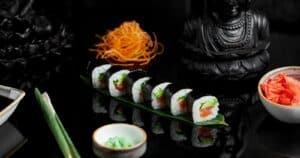Have you ever wondered why the scent of Tom Yum soup might turn some people off? We’ll unravel the mystery behind its unique aroma and explore the ingredients that contribute to its smell. Although the smell of this popular Thai soup is subjective, understanding the components can shed some light on why it may not appeal to everyone’s taste.
So, what exactly causes the distinctive smell of Tom Yum soup? Fish sauce, shrimp paste, and lemongrass are the culprits responsible for that pungent scent. While fish sauce and shrimp paste have strong aromas that can be off-putting for some, lemongrass adds its own overpowering citrusy scent. However, it’s essential to remember that these ingredients also give Tom Yum soup its unique and delightful flavor.
In the upcoming sections of this blog post, we’ll delve deeper into each ingredient and explore their individual scents and flavors. We’ll learn more about fish sauce, its role in Thai cuisine, and why it might not appeal to everyone.
The Mystery Behind Tom Yum Soup’s Unique Aroma

Tom Yum soup is renowned for its distinct and captivating aroma. The combination of herbs and spices used in this Thai soup is what gives it its unique scent. Lemongrass, kaffir lime leaves, galangal, and chili peppers are the key ingredients that contribute to its bright and enticing fragrance. But why does Tom Yum soup’s aroma stand out, and why do some people find it unpleasant or strange?
One reason for the unusual smell of Tom Yum soup is the presence of fermented ingredients. Fermentation is a traditional method used in Thai cuisine to enhance the flavors of certain ingredients. In some recipes, shrimp paste or fish sauce is added to the soup, which can give it a pungent and potent odor. While this fermented essence adds depth and complexity to the soup, it may not appeal to everyone’s taste and smell preferences.
Another factor contributing to the unique aroma of Tom Yum soup is the combination of strong and aromatic herbs and spices. Lemongrass, with its citrusy and floral scent, is the star ingredient that gives the soup its refreshing aroma. Kaffir lime leaves add a zesty and tangy fragrance, while galangal provides a strong and peppery aroma.
These ingredients, along with the heat from chili peppers, create a powerful and tantalizing scent that can be overpowering for some individuals.
It’s important to note that the smell of Tom Yum soup is subjective, and what one person may find unpleasant, another may find delightful. The distinct aroma of this soup is a normal characteristic and does not indicate that there is anything wrong with it. In fact, the strong scent is an integral part of the dining experience, as it prepares the senses for the explosion of flavors that await in each spoonful.
Fish Sauce: The Culprit Behind the Pungent Smell
Tom Yum soup is a popular dish known for its savory, salty, spicy, and sour flavors. One key ingredient that adds depth and saltiness to the soup is fish sauce. While some may find the smell of fish sauce unpleasant or overwhelming, it is an essential component of Tom Yum soup that contributes to its unique and delicious taste.
Fish sauce, often made from fermented fish or shellfish, provides umami, a savory taste that enhances the overall flavor of the soup. It also adds a necessary saltiness to balance out the other ingredients. While the smell of fish sauce can be strong, when combined with the other herbs, spices, and ingredients in Tom Yum soup, it creates a harmonious blend of flavors.
It’s worth noting that the pungent smell of Tom Yum soup can sometimes be mistaken for other odors, such as a gas leak. However, this smell is simply a result of the combination of herbs, spices, and ingredients used in the soup, including fish sauce. It is a normal characteristic of the dish and is appreciated by those who enjoy the bold and complex flavors of Tom Yum soup.
Unraveling the Strong Aroma of Shrimp Paste
Shrimp paste, a popular fermented condiment in Southeast Asian and Southern Chinese cuisines, is known for its strong aroma. This unique smell can be puzzling for some, but it is an integral part of the paste’s flavor profile.
Made by fermenting finely crushed shrimp or krill with salt for several weeks, shrimp paste develops its pungent odor during the fermentation process. However, it’s important to note that the scent of higher grade shrimp paste is generally milder compared to lower quality versions. This distinction in aroma can impact the overall taste of dishes.
Despite the potent smell, shrimp paste should be used in moderation as a little goes a long way. It is meant to add a subtle hint of flavor rather than overpowering the dish. Using too much can ruin the sauce or dip, resulting in an unpleasant taste. It is essential to strike the right balance when incorporating shrimp paste into recipes.
Shrimp paste is considered an essential ingredient in many traditional Southeast Asian dishes such as curries, sauces, and sambal. While some may find the smell of shrimp paste off-putting, it is a normal characteristic of the condiment. The distinct aroma is necessary to achieve the unique and delicious taste that defines Southeast Asian cuisine.
Lemongrass: The Overpowering Citrusy Scent
Lemongrass is a popular ingredient in Tom Yum soup and various Southeast Asian dishes due to its strong citrusy scent. While some people might find this scent overpowering, it is a normal characteristic of the herb and is essential for achieving the unique and delicious taste of these dishes.
To prepare lemongrass for cooking, start by cutting off the bottom of the stalks and trimming about 1-2 inches from the top. Then, peel off the greenish outer layers until you reach the softer whitish green layer. To release the aroma of the lemongrass, lightly smash the stalks with the side of a knife or use a mallet, similar to crushing garlic. Finally, cut each stalk into thirds.
The bruising process helps to intensify the fragrance of lemongrass, which adds a bright and citrusy flavor to Tom Yum soup and other dishes. It is an essential ingredient in these recipes, giving them their distinct Southeast Asian taste.
The overpowering scent of lemongrass can be subjective, as everyone has different preferences when it comes to fragrance. While it may be strong for some individuals, it is important to note that the potency of the lemongrass is necessary to achieve the authentic flavors associated with Southeast Asian cuisine.
Exploring the Flavors of Tom Yum Soup’s Ingredients
Tom Yum soup is a complex and flavorful dish that showcases a variety of ingredients, each contributing to its unique taste. Let’s delve into the flavors brought about by the key components of this aromatic soup:
- Lemongrass: With its bright, citrusy flavor, lemongrass adds a refreshing and zesty note to Tom Yum soup. Sliced and added to the soup, it enhances the overall taste profile.
- Kaffir lime leaves: These leaves offer a distinctive floral flavor to Thai cuisine, including Tom Yum soup. When torn into pieces and added to the soup, they infuse it with a subtle, yet delightful fragrance.
- Galangal: Similar to ginger but with a spicier, peppery kick, galangal slices are among the essential ingredients in Tom Yum soup. They contribute a unique flavor that helps elevate the soup’s complexity.
- Thai chilies: These small yet fiery peppers bring the heat to Tom Yum soup. Sliced and added to the broth, they provide a spicy kick that complements the other flavors in the dish.
- Fish sauce: Made from fermented fish, fish sauce adds a salty and umami-rich element to Tom Yum soup. It enhances the overall taste profile and gives the soup its distinct Thai flavor.
- Lime juice: The addition of lime juice brings a tangy and acidic note to the soup, balancing out the other flavors and adding a bright freshness.
- Coconut milk: This creamy liquid lends richness and a silky mouthfeel to the soup. It adds depth to the overall flavor profile, making the soup more satisfying and enjoyable.
- Protein and vegetables: While shrimp is a common protein in Tom Yum soup, other options like chicken, pork, or mixed seafood can be used. Additionally, vegetables like tomatoes, mushrooms, and onions are commonly added to enhance both the flavor and texture.
Will Tom Yum Soup go Bad?
Yes, tom yum soup can go bad if it is not stored properly. It is important to store the soup in an airtight container in the refrigerator for 2-3 days. If you want to keep it for a longer period, you can freeze it for up to 3 months. However, the texture of the mushrooms and tomatoes may not be as good after freezing, so it is recommended to add them back in fresh when you are ready to defrost and serve.
There are a few signs that indicate tom yum soup may have gone bad. If the soup has been left out at room temperature for more than 2 hours, it should be discarded to avoid the risk of foodborne illness. Additionally, if the soup has an off smell, appearance, or taste, it should not be consumed.
To ensure that tom yum soup stays fresh and safe to eat, it is best to consume it within a few days of making it. Following proper storage guidelines and paying attention to any signs of spoilage will help prevent the soup from going bad.
How to tell if Tom Yum Soup has gone bad?
Tom Yum Soup can go bad if not stored properly or left out at room temperature for too long. There are several signs to look out for to determine if the soup has gone bad:
- Foul smell: If the soup smells sour, rancid, or off, it is likely spoiled. A strong unpleasant odor indicates bacterial growth and should not be consumed.
- Change in color and texture: Tom Yum Soup should be clear and have a smooth texture. If the soup appears cloudy, discolored, or has clumps or lumps, it may have gone bad.
- Bubbles: If the soup has bubbles or is actively bubbling, it is a sign of spoilage. Bacterial fermentation can cause the soup to produce gas, resulting in bubbling.
If you notice any of these signs, it is crucial to discard the Tom Yum Soup to avoid the risk of foodborne illness. Consuming spoiled soup can lead to symptoms like stomach cramps, nausea, vomiting, and diarrhea.





